Llansantffraid-ym-Mechain (or Llansanffraid) is a large village in Montgomeryshire, close to the border with Shropshire and Denbighshire which lies about seven miles southwest of Oswestry and eight miles north of Welshpool on the A495 road and is at the confluence of the River Vyrnwy and the Afon Cain. The men of the village who fell during both World Wars are commemorated on the village war memorial, which is situated on an elevated position beside the A495 road opposite the Wynnstay Stores and takes the form of a Celtic Cross, with two inlaid bronze panels bearing the names of the fallen.
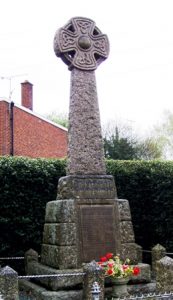
The Great War, 1914-1918
David Thomas Ellis, Private, 55193, Royal Welsh Fusiliers. David was the son of David and Rachel Ellis, of Cefn Llyfnog, Llansantffraid. He enlisted into the Montgomeryshire Yeomanry at Welshpool soon after the outbreak of war, and was posted to Park Hall Camp, Oswestry for training. David was drafted to France in the winter of 1916-17, and was posted to D Company of the 2nd Battalion, Royal Welsh Fusiliers. The battalion was attached to 19 Brigade, 33rd Division, and was on the Somme. During the coming weeks the 2nd RWF received several drafts of reinforcements, and on 8 December the now fully rebuilt battalion moved to new positions at Suzanne, between Bapaume and Péronne. The Division remained in this sector over the coming months, before being transferred to the Arras sector, and reached Henin by 13 April, before the Division took over a section of front line facing the Hindenburg Line. The infantry battalions of the division then began the usual routines of rotating between the front-line, support and reserve trenches and the 2nd RWF took over a position known as Tunnel Trench. On 23 April the 2nd RWF took part in a costly assault on the Hindenburg Line, suffering heavy casualties. The battered battalion then moved to a rest camp at Basseux to rebuild, and by 15 May moved back into the line in the Croisilles Sector. The Division then carried out several assaults against the Hindenburg Line, but could not breach it, so on 27 May 1917 a large-scale assault was carried out again, with the 2nd RWF in the thick of the action. Following the attack, the 2nd RWF moved out of the line for a rest, until moving back into the trenches at Moyenville on 19 June. Two weeks later the Division was relieved, moving to Airaines, where it spent almost a month before taking over front-line positions on the Channel coast, near Bray Dunes, in the Nieuwpoort Sector. The intention was for the Division to launch an assault along the coast, but following the failure of the army to break out at Ypres, the Division was rushed to the city, before taking over positions facing Polygon Wood by 25 September, joining the Passchendaele offensive. Over the coming days the Division saw terrible fighting for the wood, before being relieved, and moved to the Messines Sector the following month. David was wounded soon afterwards, and was evacuated to hospital in Bailleul, where he died of his wounds on 11 October 1917. The 27-year-old is buried in Bailleul Communal Cemetery Extension, France.
Edward Delmé Evans, Private 55318, Welsh Regiment. Edward was born at Llandovery in 1897, the son of Edward and Jane Evans. The family was living at 14, Signal Terrace, Oswestry by 1901, and Edward’s father was working in the town as a clogger. By 1911 the family had moved to 8, Ash Road, Oswestry and young Edward worked for the Great Western Railway at Oswestry. He enlisted at Oswestry into the King’s Shropshire Light Infantry and after completing his training was drafted to France in the summer of 1917, joining the 2nd Battalion, Welsh Regiment, which was attached to 3 Brigade, 1st Division. The Division had followed the German withdrawal to the Hindenburg Line in March 1917, then the 2nd Welsh spent several weeks undergoing training and rebuilding at Chuignes and Rouy-les-Grand before moving to Roisel by 27 April and Flêtre by the beginning of June. Edward probably joined the 2nd Welsh at Flêtre on 8 June, just before the battalion moved to Dickebusch Lake, in the Ypres Salient with the 1st Division. The battalion then began supplying working parties in the St. Eloi sector, before the Division moved to Caestre on 16 June, preparatory to the entire Division being transferred to Le Clipon Camp, near Coxyde on the Flanders coast, to prepare for a possible offensive. The operation was cancelled when it became clear that the Passchendaele offensive had bogged down, so on 7 November 1917 the Division entrained for the Ypres Salient, taking over a section of the front line on Passchendaele Ridge the following day. On 10 November the 2nd Welsh took part in an assault against the ridge, but was forced to withdraw to Irish Farm. The battalion was relieved on the following day and marched back to Dambre Camp to rest, then on 15 November moved back into the front line near the Paddebeek. Edward was killed in action here by enemy shellfire on 17 November 1917. The 20-year-old has no known grave and is commemorated on the Tyne Cot Memorial, Belgium. The family later resided at Tanyard Row, Llansantffraid, but Edward is not commemorated on the Llansantffraid-ym-Mechain war memorial.
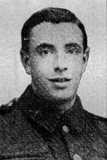

George Fred Evans, Private, 52165, Machine Gun Corps. George was born on 23 April 1895, the son of Alfred and Elizabeth Evans, of Cefnllwyd Cottages, Llansantffraid. He enlisted at Newtown into the 2/1st Battalion, Welsh Horse Yeomanry soon after the outbreak of war. The battalion had formed at Newtown in 1914 and in July 1915 joined the 2/1st South Wales Mounted Brigade in the Dorchester area. During September 1915 the brigade moved to Yoxford joining the 1st Mounted Division. At some time in 1916 George was drafted to France, joining the 2nd Squadron, Machine Gun Corps, a Cavalry unit. The unit formed in France on 28 February 1916, joining the 2nd Cavalry Brigade, 1st Cavalry Division. Due to the stagnant nature of trench warfare, the Cavalry Divisions were rarely used, as there was hardly ever any opportunity during the war to exploit any breakthroughs with the use of mounted troops, so it was not until the Battle of Flers-Courcelette on 15 September 1916, during the Somme offensive, that George would have seen his first major action. The 1st Cavalry Division then took part in the Battle of Arras during April 1917, but remained mainly in reserve to the infantry, ready to mount attacks in case of any breakthroughs. The Division saw heavy fighting during the Cambrai offensive, however, taking part in the initial tank attack on 20 November and being present during the capture of Bourlon Wood, before seeing more fighting following the German counter-attacks from 30 November. The 1st Cavalry Division remained in the area over the winter, in positions in front of Roisel, facing the Hindenburg Line. When the Germans launched their great Spring offensive on 21 March 1918, the 1st Cavalry Division was ordered to man its battle positions, but suffered mainly from shellfire during the opening day. At about 10.00 on 22 March 1918 the Germans attacked Roisel and the Machine-Gun crews came into action, desperately trying to stop the advancing German infantry before being surrounded. George was killed in an action during the desperate defence of Roisel that morning. The 22-year-old has no known grave and is commemorated on the Pozieres Memorial, France. He is not commemorated on the Llansantffraid-ym-Mechain war memorial.
Richard Allen Evans, Gunner, 245122, Royal Field Artillery. Richard was the son of Richard and Sarah Evans, of Godar Fach, Llansantffraid. He enlisted into the Royal Field Artillery at Llanfyllin, and was posted to B Battery, 293rd Brigade, RFA. The battery embarked at Southampton for Le Havre on 21 January 1917, as part of the 58th (London) Division, but was soon transferred to Army Troops. The battery saw its first major action at Bullecourt, during the Battle of Arras, that spring. The battery probably saw action at the Battle of Cambrai later that year, before wintering in the sector. On 21 March 1918, the Germans launched the first phase of their Spring offensive along the section of the front running south from Croisilles to La Fère. Richard’s battery was caught up in the desperate fighting which ensued, positioned near the village of Morchies. He was killed in action on that opening day of the offensive, 21 March 1918. The 34-year-old is buried in Beaumetz Cross Roads Cemetery, Beaumetz-Les-Cambrai, France.
Robert William Griffiths, Private, 3590, Welsh Guards. Robert was the son of Evan and Mary Griffiths, of 4, Rose Cottages, Llansantffraid. He enlisted into the Welsh Guards at Welshpool and was drafted to France in the summer of 1917 to join the 1st Battalion, Welsh Guards, which was attached to the 3rd Brigade, Guards Division. The division had remained in the Somme sector over the winter of 1916-17, and in March 1917 took part in the advance caused by the German Retreat to the Hindenburg Line. Later that year the Division moved north to Ypres and fought at the Battle of the Pilckem Ridge, the opening phase of the Passchendaele offensive. The Guards Division saw further fighting at Ypres, during the later stages of the offensive, being in support for an assault by the Guards Division towards the Broombeek on 10 October, before advancing the line on the following day. The Guards Division was relieved soon afterwards, moving to Serques to rest and rebuild, before being moved south on 9 November, to take part in the Battle of Cambrai. By 23 November the Guards had taken over the Flesquières sector, to bolster its defences following the launching of a German counter-attack which had been launched on the previous day. Heavy fighting then ensued over the coming days, some of the fiercest of which the Guards has seen since the beginning of the war. Robert was killed in action near Gouzeaucourt on 1 December 1917, in a terrible day of fighting which saw the Welsh Guards suffer 270 casualties. The 19-year-old has no known grave and is commemorated on the Cambrai Memorial, Louverval, France. Robert is not commemorated on the Llansantffraid-ym-Mechain war memorial.
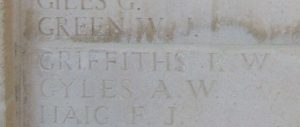
David Jones, Private, 244372, Cheshire Regiment. David was the son of Thomas and Jane Jones, of Gate House, Llansantffraid-ym-Mechain. He moved to 29, Willow Street, Oswestry by 1911, and worked in the town as a butcher. David enlisted into the 13th Battalion, Cheshire Regiment at Port Sunlight soon after the outbreak of war. The battalion was raised at Port Sunlight by Gershom Stewart, MP on 1 September 1914, moving to Chester. During October 1914 the battalion moved to Salisbury Plain joining 74 Brigade, 25th Division. It spent the winter in billets in Bournemouth before moving to Aldershot for final training, then on 25 September 1915 David landed in France with the battalion, which moved with the 25th Division to Flanders for trench initiation before taking over the Vimy area, where the Division defended Vimy Ridge against a German attack in May 1916. The Division then moved to the Warloy area and attacked on 3 July near Thiepval. It fought throughout the Battle of the Somme, and then moved to Ploegsteert, where the Division held the line for the months leading up the Battle of Messines in June 1917. After fighting at Messines, the Division moved north, and fought at Pilckem, before moving south again, where it took up positions around Bullecourt in reserve. David was later transferred to the 1/5th Battalion, Cheshire Regiment, which was the Pioneer Battalion to the 56th Division. The Division had seen heavy fighting during the German spring offensive of 21 March 1918, yet remained in the Arras Sector after the fighting had calmed down. Over the coming weeks the 5th Cheshire’s were hard at work improving the Feuchy trench system. On 22 May David was among ten men of the battalion wounded by German artillery fire. The 22-year-old was taken to a Casualty Clearing Station at Averdoingt, where he died of his wounds on the following day, 23 May 1918. David is buried in Ligny-St. Flochel British Cemetery, Averdoingt, France. He is not commemorated on the Llansantffraid-ym-Mechain war memorial.
David Thomas Jones, Private, 23899, King’s Shropshire Light Infantry. David was born at Llansantffraid-ym-Mechain in 1886, the son of John and Mary Ann Jones. David worked for several years at Melyning Fawr Farm, Llansantffraid, but by 1911 his father had died and David and an elder sister Emma were living with their widowed mother at 37, Ash Road, Oswestry. David worked as a maltster’s labourer prior to the war. He enlisted into the King’s Shropshire Light Infantry at Oswestry and was posted to France early in 1916, joining the 5th Battalion, King’s Shropshire Light Infantry, which was attached to 42 Brigade, 14th (Light) Division. David probably joined the battalion at Elverdinghe in January 1916, among a small number of drafts. During July 1916 the Division moved to the Somme, and fought at the Battle of Delville Wood. It then took part in the Battle of Flers-Courcelette, which saw the first use of tanks in action, before wintering on the Somme. During March 1917 the Division followed the German Retreat to the Hindenburg Line. May saw the Division at Arras, where it took part in the First Battle of the Scarpe, and later at the Third Battle of the Scarpe. The Division then enjoyed several weeks behind the line around Puchevillers, training and refitting before entraining for Bailleul on 12 July 1917 and remained there over the coming weeks. The Third Battle of Ypres opened on 31 July 1917, and by 16 August the 14th Division entered the fray, moving to a camp near Dickebusch before taking over a section of the line between Hooge and Zillebeke, east of Ypres. The Division then took part in the Battle of Langemarck and then in the First Battle of Passchendaele, which was launched on 12 October and was a major assault against the ridge itself. On 11 October the 5th KSLI had moved from billets at Berthen to huts at Ridge Wood, where a number of drafts joined the battalion. On 16 October 1917 the 5th KSLI went forward and relieved the 8th KRRC in the front line north of the Menin Road, near Gheluvelt. The battalion was heavily shelled during the relief, suffering the loss of one officer and one man missing; eleven killed and 29 wounded, even before they had fired a shot. The 31-year-old David was among those killed that day. He has no known grave and is commemorated on the Tyne Cot Memorial, Belgium. David is not commemorated on the Llansantffraid-ym-Mechain war memorial.
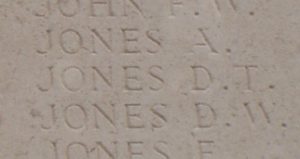
George Thomas Jones, Corporal, 5923, Welsh Regiment. George was born on 27 January 1883, the son of William and Eliza Jones, of 2, Cambrian Terrace, Llansantffraid-ym-Mechain. He married Winifred Powell at Llansantffraid in 1908 and the couple lived at Chapel House, Llansantffraid. George was probably an army reservist, and upon being mobilized, embarked for France on 23 November 1914, joining the 2nd Battalion, Welsh Regiment at Ypres. The battalion was attached to 3 Brigade, 1st Division and had suffered heavy casualties during the opening months of the war, taking part in the Battle of Mons and the subsequent retreat to the Marne, and then helped stop the Germans at the Battles of the Marne and Aisne, before the BEF moved to Ypres. The Division had then played a vital role in stopping the Germans capturing the important city, during the First Battle of Ypres, before wintering in Flanders. The 1st Division took part in its first major action of 1915 at Richebourg on 9 May 1915, during the Battle of Aubers Ridge, when it attacked alongside the Meerut Division. The attack of the 2nd Welsh was held up by a flooded ditch, which the men forded, before being hit by heavy machine-gun fire, and a large number of casualties were suffered before the survivors withdrew. The Division then moved south to the Loos sector, where it prepared for the launching of the Battle of Loos. On 1 September 1915 the 1st Division was relieved from the line and moved to billets at Annezin, before moving to Auchel the following day. The men then began cleaning up their kit before starting a variety of training schemes and several moves followed before the Division returned to the line by 12 September. The opening day of the Battle of Loos was 25 September 1915. The 2nd Welsh, initially in reserve, advanced during the morning into old French trenches in front of Vermelles. The men in the front lines waited until the Royal Engineers released a gas cloud onto the Germans before launching their assault at 07.30. The wind had, however, died down and the waiting troops were astonished to see the white gas cloud be released and hang over the battlefield in front of them, and in some cases blow back over the British lines, yet the assault went ahead as planned. Little gains were made, yet the 2nd Welsh entered the fray soon afterwards to join in the terrible fighting which was raging. George was killed at some time during the day. The 32-year-old has no known grave and is commemorated on the Loos Memorial, France.
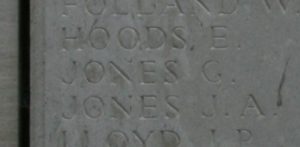
Glynne Jones, MSM, Lance Corporal, 15359, Machine Gun Corps. Glynne was the son of Ellis Jones and Hannah Jones (nee Mason), of Brynawel, Llansantffraid-ym-Mechain. Glynne and a brother, Frank, were raised by their grandmother, Ann Mason, at Llansantffraid. Glynne enlisted into the Welsh Regiment at some time in 1916 and was posted to Kinmel Park for training. Glynne was initially posted to the Welsh Regiment, with the number 39761, but on 5 March 1918 was posted to the newly formed 24th Battalion, Machine Gun Corps, his number changing to 15359. The battalion was formed at Devise from the merging of the 17th, 72nd, 73rd and 191st Machine Gun Companies, as part of the 24th Division, which was holding a sector of front line from Jeancourt-Le Verquier-Vadencourt-Maissemy, facing the Hindenburg Line and the battalion HQ moved to Vraignes. A number of extra drafts, including more officers and a new RSM joined the battalion over the coming days as it settled into its positions. At 04.00 on 21 March 1918 the gun crews of the battalion were in this new line when the Germans opened up a tremendous artillery barrage along the front, before launching an infantry assault along a section of the front line running south from Croisilles to La Fère. The 24th Battalion was not in action straight away, but SOS flares could be seen going up either side of their section of the line, so the men were totally aware of the situation when the Germans finally hit them by around 15.30. Heavy fighting was then raging all along the front and the Machine-Gun crews were in action attempting to slow down the ferocious German onslaught, but bit by bit units were being overwhelmed and in some sectors the Germans broke through, forcing a series of strategic withdrawals over the coming days. Glynne was posted as missing, believed killed in action during that first day of the German offensive, on 21 March 1918. No trace of the 20-year-old was ever found, so he is commemorated on the Pozieres Memorial, France. He was posthumously awarded the Meritorious Service Medal; the award being published in the London Gazette of 17 June 1918.
John Jeffreys Jones, Private, 2290, Welsh Guards. John was the son of Sarah Jones, of Pentre Cottages, Llansantffraid-ym-Mechain. He worked as a waggoner for William Gough at Melyniog Fawr prior to the war. John enlisted into the Welsh Guards soon after its formation by Royal Warrant of 26 February 1915. The Welsh Guards trained at White City, before landing at Le Havre on 18 August 1915, becoming attached to 3rd Guards Brigade, Guards Division. The Division had seen its first major action during the Battle of Loos, which began on 25 September 1915, and had suffered heavy casualties at Hill 70, before also taking part in the Action of the Hohenzollern Redoubt. The Division had a brief rest in the Calais area, before moving to the Ypres Salient, and held the line at Potijze for several months. At the end of July 1916, the Division withdrew from Ypres and moved to the Somme, before holding the line north of the Ancre for a short period. By 25 August the Guards Division had moved slightly south, and had marched passed Corbie, to Mericourt-L’Abbe. By 9 September the Guards had passed Ginchy, and moved into positions at Guillemont, prior to taking part in the Battle of Flers-Courcelette, the first-time tanks were ever used in action. The Guards Division saw heavy fighting at Flers, and then during the ensuing Battle of Morval, capturing Lesboeufs Village. After the Somme offensive had died down, the Guards remained on the Somme for the winter. On 26 December the Welsh Guards moved into the front line between Bouleaux Wood and Haie Wood, to begin a routine tour in the trenches. John was wounded during this spell in the line and died of his wounds on 29 December 1916. The 22-year-old is buried in Bronfay Farm Military Cemetery, Bray Sur Somme, France. By the time of his death his mother was living in Norfolk.
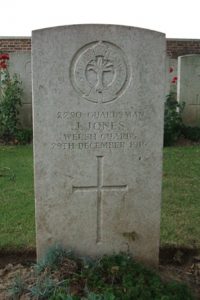
Joseph Pryce Jones, Private, 22482, South Wales Borderers. Joseph was born in 1887, the son of Thomas Jones and Annie Jones (nee Casewell), of Llansantffraid-ym-Mechain. He married Isabella Maud Williams at Llangedwyn on 2 May 1912, and the couple had two children. Joseph worked as a waggoner at Llangedwyn prior to moving to South Wales to find work. Joseph enlisted into the 11th Battalion, South Wales Borderers at Newport, Monmouthshire soon after the outbreak of war. The battalion was raised at Brecon by the Welsh National Executive Committee before moving to Colwyn Bay, joining 130 Brigade, 43rd (Welsh) Division. The Division trained in North Wales before moving to Winchester in the summer of 1915, where the formation became renumbered 115 Brigade, 38th (Welsh) Division. The Division moved to France on 2 December 1915 and moved to the Nursery Sector near Fleurbaix for trench initiation alongside the Guards Division. The Division then held a sector of the line near Cuinchy before marching south to the Somme sector in June 1916 to take part in the assault on Mametz Wood. The first attack on the wood was launched on a two-battalion front on 7 July, but failed, with the 16th Welsh in particular being almost decimated. Joseph was killed in action during the initial assault that day, 7 July 1916. The 27-year-old has no known grave and is commemorated on the Thiepval Memorial, France. Joseph is not commemorated on the Llansantffraid-ym-Mechain war memorial.
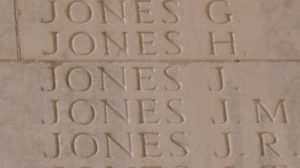
Cecil Kilvert, Private, 291039, Royal Welsh Fusiliers. Cecil was born in Ruyton XI Towns in 1897, the son of Joseph Kilvert and Mary Jane Kilvert (nee Brown). The family had moved to Llansantffraid-ym-Mechain by 1911. Cecil enlisted into the 4th Battalion, Royal Welsh Fusiliers at Wrexham and was drafted to France in the winter of 1916-17, joining the 2nd Battalion, Royal Welsh Fusiliers, which was attached to 19 Brigade, 33rd Division. The 2nd RWF had suffered terrible casualties on the Somme during August 1916 before the 33rd Division was relieved at the end of the month. During the coming weeks the 2nd RWF received several drafts of reinforcements, and on 8 December the now fully rebuilt battalion moved to new positions at Suzanne, between Bapaume and Péronne. The Division remained in this sector over the coming months, before being transferred to the Arras sector, and reached Henin by 13 April, before the Division took over a section of front line facing the Hindenburg Line. The infantry battalions of the division then began the usual routines of rotating between the front-line, support and reserve trenches and the 2nd RWF took over a position known as Tunnel Trench. On 23 April the 2nd RWF took part in a costly assault on the Hindenburg Line, suffering heavy casualties. The battered battalion then moved to a rest camp at Basseux to rebuild, and by 15 May moved back into the line in the Croisilles Sector. The Division then carried out several assaults against the Hindenburg Line, but could not breach it, so on 27 May a large-scale assault was carried out again, with the 2nd RWF in the thick of the action. Cecil was killed in action during the assault that day, 27 May 1917. The 20-year-old has no known grave and is commemorated on the Arras Memorial, France.

Audley Andrew Dowell Lee, MC, Captain, Leicestershire Regiment. Audley was born at Deytheur, Llansantffraid-ym-Mechain on 3 April 1895, the second son of Reverend William Benjamin Dowell Lee and Katherine Lee (nee Middlemass). He was educated at Oundle and then at Lincoln College, Oxford, where he joined the Officer Training Corps. Audley was commissioned as Second Lieutenant into the Leicestershire Regiment from the OTC on 22 December 1914. Audley embarked for France on 21 November 1915, and joined the 9th Battalion, Leicestershire Regiment, which was at Bienvillers attached to 110 Brigade, 21st Division. The Division was holding the line in the Monchy sector at the time of Audley’s arrival, following heavy losses at Loos in September. In May 1916 the Division moved to the Somme, taking over a section of the line at Hannescamps. The Division remained in reserve during the opening days of the Somme offensive but on 10 July took over positions at Quadrangle Support and Trench before taking part in the attacks on Bazentin Ridge after the 38th (Welsh) Division withdrew from Mametz Wood. Audley was conspicuous in his bravery whilst leading his platoon during the ensuing fighting and was promoted to Captain in October 1916, gaining command of A Company, then was awarded the Military Cross for his gallantry throughout the Somme campaign. The award was published in the 1917 New Year’s Honours List. In March 1917 the Division followed the German Retreat to the Hindenburg Line, and in April fought at Arras, during the First Battle of the Scarpe, the Third Battle of the Scarpe, and the Flanking Operations Round Bullecourt. During September 1917 the Division moved to Ypres, and by 30 September had moved into the line east of Polygon Wood. During the early hours of 1 October 1917, the Division was subjected to an intensive artillery barrage and minutes later the line was hit by waves of German infantry, who had crossed No Man’s Land behind the screen of the barrage. Audley, leading his company from the front, was killed soon afterwards. The 22-year-old has no known grave and is commemorated on the Tyne Cot Memorial, Belgium.

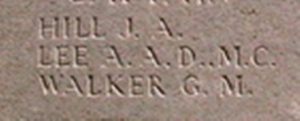
George Nelson Lloyd, Private, 30719, East Lancashire Regiment. George was the son of Richard and Jent Lloyd, of Court House Cottage, Llandysilio. He enlisted into the army at Wrexham, and after completing his training was posted to France, joining the 11th Battalion, East Lancashire Regiment, which was attached to 94 Brigade, 31st Division. He would have joined the battalion in the late summer of 1917, while it was in the Arras sector, near Ecurie. The Division was holding the Oppy Sector of the Arras front, and had a relatively peaceful time over the winter of 1917-18, suffering very few casualties. During February the 11th East Lancs transferred to 92 Brigade, in the same 31st Division, following the re-organisation of the British Army in France. Over the coming weeks the infantry battalions of the Division continued to carry out the usual routines of trench rotation, normally four days in the front line, four in support and four in reserve. The battalion was in reserve at Marquay when the Germans launched their Spring Offensive on 21 March 1918, along the section of front running from Croisilles to La Fère, and on the following day was ordered to move forward to Bailleulval, taking over a section of defensive line east of Boisleux St. Marc. On the following day the battalion took over a new defensive line in front of Ervillers, where it awaited the German onslaught. On 25 March information was received that the Germans had broken through at Gomiecourt, and the 11th East Lancs was ordered to withdraw. On 27 March the Germans hit the line held by the battalion, and fierce fighting ensued. George was killed in action near Adinfer Wood on the following day, 28 March 1918. The 19-year-old has no known grave and is commemorated on the Arras Memorial, France.
Edward Morris, Private, 54804, The King’s (Liverpool Regiment). Edward was the son of John and Jane Morris, of Llansantffraid-ym-Mechain. He married Catherine Ann Thomas at Llansantffraid on 10 May 1912 and the couple set up home at The Smithy. Edward worked as a waggoner prior to the war. He enlisted into the army and was originally posted to the Cheshire Regiment. He served on the Western Front before being transferred to a Labour Company of the King’s (Liverpool Regiment). Edward took ill towards the end of the war and was taken to Oswestry Cottage Hospital, where he died of tuberculosis on 14 December 1918. The remains of the 36-year-old were brought home for burial in St. Ffraid’s Churchyard, Llansantffraid-ym-Mechain. His widow was left to raise their two children alone and died in 1964.
John Henry Morris, Gunner, 67047, Royal Field Artillery. John was the son of John and Jane Morris, of Winllan Cottage, Llansantffraid-ym-Mechain. He worked as a general labourer prior to enlisting into the Royal Field Artillery at Seaforth, Lancashire. John was posted to C Battery, 53rd Brigade, Royal Field Artillery. The battery had been formed as part of the 9th (Scottish) Division, initially training in Scotland before being posted to Salisbury then to Bordon, in Hampshire to complete its training. John then embarked for France with the battery at Southampton on 11 May 1915 and the entire Division moved to the Bois Grenier sector for trench initiation. By September the 53rd Brigade, RFA had moved to positions near Annequin, and from 25 September onwards supported an assault by the 9th Division during the Battle of Loos. During the opening days of October, the Division was relieved and entrained for the Ypres Salient, and the battery set up in positions south-east of Ypres and there was a reorganization in personnel among the senior officers, with several promotions and new arrivals joining. As the New Year dawned, the Division moved to the Le Bizet-Ploegsteert area before moving to positions at Nieppe. On 1 June the Division began to move from Flanders, entraining for Amiens and by 13 June the 53rd Battery had gone into billets at Corbie, in readiness to take part in the forthcoming Somme offensive. The Divisional artillery then set up in positions between Carnoy and Maricourt where, on 1 July 1916, their guns opened fire during the preliminary bombardment which covered the opening infantry assaults of the Somme offensive. Over the coming days John’s battery maintained its work, often firing shrapnel in attempts to cut wire defences prior to infantry assaults and slowly began moving its guns forwards as the front line advanced. By 16 July the battery was situated at Bernafay Wood and was in action supporting the fighting for Delville Wood. John was killed by German counter-battery fire on 20 July 1916. The 30-year-old was originally buried on the battlefield alongside two other men of his battery, but on 7 July 1919 their graves were exhumed by men of the 113th Labour Company and were re-buried in Quarry Cemetery, Montauban, France.
William Morris, Private, G/15771, The Queen’s Royal West Surrey Regiment. William was born at Llansantffraid-ym-Mechain in about 1885. By 1911 he was living at Woking, where he worked as a draper. He married Emma Brooke at Swindon early in 1915 and on 4 August that year, Emma gave birth to twin girls, Edith and Winifred. William enlisted at Guildford into The Queen’s Royal West Surrey Regiment and after completing his training, was drafted to France early in 1916, joining the 8th Battalion, The Queen’s, which was attached to 72 Brigade, 24th Division. The Division had moved to France during August 1915 and, despite its inexperience, was sent into action at Loos on 26 September 1915, suffering terrible casualties. It was then withdrawn from the line to refit and didn’t see action until the summer of 1916 when it was moved to the Somme. It then fought at Delville Wood and Guillemont, before being relieved on 6 September, moving back north to positions at Camblain-l’Abbé, in the Vimy sector, north of Arras. Here the Division began work preparing to launch an offensive against Vimy Ridge alongside the Canadian Corps. The offensive was launched on 9 April 1917 and the 24th Division attacked on the northern flank, north of the Souchez river, with the Canadians to the south. The 8th Queen’s was in reserve during the initial phase of the battle, billeted behind the lines at Bully-Grenay. On 11 April 1917 William was in his billets at Bully when a German shell crashed into D Company’s billets, killing William and three other men and wounding eight others. William was 32 years old when he was killed that day and is buried in Bully-Grenay Communal Cemetery, British Extension, France. William is not commemorated on the Llansantffraid-ym-Mechain war memorial.
William Parkes, Private, 49889, Royal Welsh Fusiliers. William was the son of Thomas and Elizabeth Parkes, of Pentre Cottages, Llansantffraid-ym-Mechain. He worked as a hawker prior to enlisting into the Royal Field Artillery at Llanfyllin. William was drafted to France in the spring of 1917 and was posted to the 13th Battalion, Royal Welsh Fusiliers. The battalion was attached to 113 Brigade, 38th (Welsh) Division and had moved to Ypres with the Division in September 1916, following its assault on Mametz Wood in July. The Division then took over the Canal Bank sector at Boesinghe. The infantry battalions of the Division then began carrying out the normal pattern of rotation in the trenches, four days in the front, four in support and four in reserve, whilst also working on trench improvement, digging new trenches, and also carrying out regular patrols and trench raids. On 31 July 1917 the Division launched its famous assault on the Pilckem Ridge, capturing Iron Cross and reaching its objective of the Steenbeek, then played a supporting role in the Battle of Langemarck. The Division was transferred to the Sailly-sur-la-Lys sector in September and remained in the area over the winter before being moved to positions north of Albert, at Bouzincourt Ridge, at the end of March 1918, relieving the battered 2nd and 47th Divisions. It held this sector, again carrying out minor operations and trench raids, over the coming months, before taking part in the great offensive of 21 August 1918, and began its advance towards the Hindenburg Line. William was badly wounded during the initial stage of the advance, following the assault by the 13th RWF east of Albert towards Crucifix Corner. He was evacuated to hospital at Le Treport, where he died of his wounds on 29 August 1918. The 29-year-old is buried in Mont Huon Military Cemetery, Le Treport, France.
Thomas Francis Parry, Private, 17243, King’s Shropshire Light Infantry. Thomas was born in Llansantffraid-ym-Mechain, the son of Robert and Mary Parry. By 1911 his parents were residing at Yew Tree Cottage, Llanymynech, whilst Thomas worked as a waggoner at Penrhos, Llanymynech. Thomas enlisted into the 5th Battalion, King’s Shropshire Light Infantry at Oswestry soon after the outbreak of war. The battalion formed at Shrewsbury, before moving to Aldershot, joining 42 Brigade, 14th (Light) Division. On 20 May 1915 the battalion landed at Boulogne, and the entire Division assembled in the Ypres Salient, before taking over the Zillebeke Sector. The Division was to see its first action during the Action of Hooge on 30 July 1915, where it became the first Division to be attacked by the German use of flamethrowers. The Division then fought at the Second attack on Bellewaarde, a diversionary assault launched on 25 September 1915, in an attempt to divert German attention away from the main offensive at Loos. The 5th KSLI alone suffered 420 casualties during the attack, before being relieved the following day. The 14th Division remained at Ypres over the winter. On 31 January 1916 the 5th KSLI moved back into the front line to begin a routine spell in the trenches, which proved to be its last in the Ypres Salient, for now. During February the Division moved out of the Salient and began moving south, spending a short while holding a section of the line in the Arras sector before moving further south, to the Somme, by 8 August. The 5th KSLI moved to billets at Buire-Sur-L’Ancre, where it remained until 12 August when the men marched to bivouacs at Fricourt, then on 18 August the battalion marched further forward to Pommiers Redoubt and Montauban Alley. On the night of 19-20 August, the battalion moved forward again and took up positions at Devil’s Trench, in the devastated Delville Wood. Thomas was wounded during the advance to Delville Wood and was evacuated to the Casualty Clearing Station at Heilly, in the Somme Valley, where he died of his wounds on 21 August 1916. The 28-year-old is buried in Heilly Station Cemetery, Mericourt-L’Abbe, France. Thomas is not commemorated on the Llansantffraid-ym-Mechain war memorial.
Samuel Roberts, Private, 44107, Royal Welsh Fusiliers. Samuel was the husband of Mary Emily Roberts, of Fouriog Cottage, Llansantffraid-ym-Mechain. He enlisted into the 3rd Battalion, Royal Welsh Fusiliers on 12 July 1916 and was posted to Litherland Camp, Liverpool for training. Samuel only served for five months before being medically discharged on 15 December 1916 and returned home to his wife and son, Samuel Junior. His short service with the army appeared to affect his health and over the coming years Samuel became depressed. He was found dead in Finnant Wood, Llansantffraid-ym-Mechain on 4 June 1921, after having apparently committed suicide. His widow was awarded a war pension, so his condition must have been deemed to have arisen due to his service. Nothing further is known of the 54-year-old, a he is not commemorated as a casualty of war by the CWGC and he is not commemorated on the Llansantffraid-ym-Mechain war memorial.
Harry Salter, Private, 10112, South Wales Borderers. Harry was the son of George Henry Salter and Mary Salter (nee Davies), of Waterloo Terrace, Llansantffraid-ym-Mechain. He worked as a plasterer and had served with the King’s Shropshire Light Infantry at some time prior to the war. Harry was probably an army reservist when war erupted and he enlisted at Welshpool into the 3rd Battalion, South Wales Borderers. On 28 July 1915 Harry embarked at Avonmouth aboard the troopship HMT Royal Edward, along with 1,366 other officers and men bound for Gallipoli as reinforcements for the battered 29th Division. Harry was destined to join the 2nd Battalion, South Wales Borderers. The battalion had been in China at the outbreak of war and had taken part in the famous attack on Tsingtao, where the German held port was captured, before being brought back to England and had landed at Gallipoli with the 29th Division on 25 April 1915. Royal Edward reached Alexandria by 10 August before sailing for Mudros Harbour, on the Greek island of Lemnos. On the morning of 13 August 1915, Royal Edward passed the British hospital ship Soudan, which was evacuating casualties from Gallipoli and was heading in the opposite direction. Both ships were sighted by the awaiting German submarine UB-14 and soon afterwards the submarine torpedoed Royal Edward, which sank quickly. Soudan made a quick turn and managed to rescue some 440 men, while some French and British destroyers arrived which rescued a further 221 men. Sadly, Harry was among 935 men who went down with the ship that day. The 34-year-old has no known grave but the sea, so is commemorated on the Helles Memorial, Gallipoli. His brother, Herbert, was killed on the Somme the following year.
Herbert Salter, Sergeant, 8560, Rifle Brigade. Herbert was the son of George Henry Salter and Mary Salter (nee Davies), of Waterloo Terrace, Llansantffraid-ym-Mechain. He was a regular soldier prior to the war, and was serving with the 2nd Battalion, Rifle Brigade in India. On 20 September 1914 the battalion sailed from Bombay for Britain, arriving at Liverpool on 22 October. The battalion then entrained for Hursley Park, Winchester joining 25 Brigade, 8th Division. The Division had been formed during October 1914, by the bringing together of regular army units from various points around the British Empire and embarked for the Western Front in November 1914, as a badly needed reinforcement to the BEF which had been all but wiped out at Ypres, moving to positions near Laventie. The Division saw its first major action at the Battle of Neuve Chapelle on 10 March 1915, and then took part in the ensuing Battle of Aubers Ridge on 9 May, which was an Anglo-French offensive intended to draw German attention away from the Eastern Front. The Division then took part in another diversionary action, the Action of Bois Grenier on 25 September 1915, which was intended to draw German attention away from the main assault at Loos. Herbert was transferred to the 12th Battalion, Rifle Brigade around this time. The battalion had landed in France on 22 July 1915 attached to 60 Brigade, 20th (Light) Division and moved to the Fleurbaix Sector for trench familiarisation and training. When the Battle of Loos was launched on 25 September 1915 the Division also fought a diversionary attack towards Fromelles. Later that year the Division moved north, and fought at the Battle of Mount Sorrel alongside the Canadian Corps. The Division transferred to the Arras Sector in July and spent a short while holding the line there until moving further south, to the Somme, in the middle of August 1916, moving to the line near Trônes Wood with orders to assault Guillemont. The Division saw heavy fighting around Guillemont over the coming days, then took part in the Battle of Flers-Courcelette. On 6 October the 12th Rifle Brigade, after enjoying a short rest from the action, marched into the front line once more, taking up positions preparatory for an assault on Le Transloy. At dawn the following day, 7 October 1916, the battalion launched its assault upon its objectives of Rainbow Trench, Le Transloy and Cloudy and Misty Trenches. Herbert was killed in action during the assault that morning. The 32-year-old has no known grave and is commemorated on the Thiepval Memorial, France. His brother, Harry, had been killed whilst en-route for Gallipoli the previous year.
William Edward Tisdale, Private, 3275, Royal Welsh Fusiliers. William was the son of William Tisdale and Eliza Tisdale (nee Jones), of Bronheulog, Deythur, Llansantffraid-ym-Mechain. He enlisted at Welshpool into the 7th Battalion, Royal Welsh Fusiliers soon after the outbreak of war. The battalion was a Territorial unit, which mobilised for war at Newtown in August 1914, as part of North Wales Brigade, Welsh Division and moved to Conway until the end of the month, before moving to Northampton. In December the Division moved to Cambridge and then in May 1915 to Bedford, where the Division was numbered and the formation became 158 Brigade, 53rd (Welsh) Division. On 19 July 1915 the entire Division sailed from Devonport for Imbros and on 9 August 1915 landed at Suvla Bay. The infantry moved off the beaches across the Salt Lake, under shellfire, into the scrub covered Chocolate Hill, but due to a lack of maps and no knowledge of the terrain, many of the units became disorientated, and the situation became chaotic. After the fighting died down, the winter rolled in, and the men first had to endure torrential downpours, which flooded the trenches, before the snow hit, and many men began falling ill in the terrible conditions. William took ill during the terrible winter of 1915-16 and was evacuated by hospital ship to Mudros island. He died of enteric fever at the 5th Australian General Hospital, Mudros on 12 November 1915. The 19-year-old is buried in Portianos Military Cemetery, Lemnos, Greece.
Richard Vaughan, Private, 74741, Machine Gun Corps. Richard was the son of John Edward and Jane Elizabeth Vaughan, of The Hollies, Waen Fach, Llansantffraid-ym-Mechain. He worked as a waggoner at Bryndial Farm, Welshpool prior to the war. Richard enlisted at Welshpool into the Montgomeryshire Yeomanry. On 5 August 1914 the Montgomeryshire Yeomanry was mobilised at Welshpool, as part of the South Wales Mounted Brigade, before moving via Hereford to Thetford, to join the 1st Mounted Division. On 4 March 1916 the 1st Mounted Division sailed for Egypt to join the EEF. On 4 March 1917 the battalion merged with the Welsh Horse Yeomanry to form the 25th (Montgomery & Welsh Horse Yeomanry) Battalion, Royal Welsh Fusiliers, as part of the newly formed 231 Brigade, 74th (Yeomanry) Division. Richard was then transferred to the 210th Company, Machine Gun Corps, which was attached to the same 74th Division. The Division had assembled in Egypt as part of the EEF, before crossing the Suez Canal into the Sinai, and saw its first major action during the Second Battle of Gaza. The battle was a failure, and the EEF was re-organised under a new commander, Sir Edmund Allenby, before launching the Third Battle of Gaza on the night of 31 October 1917. This assault was launched along a winder front, running from Gaza to Beersheba, and this time the EEF prevailed, opening the door to Jerusalem. Richard was killed in action at Beersheba on 31 October 1917. The 24-year-old is buried in Beersheba War Cemetery, Israel.
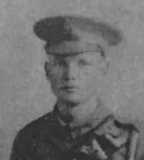
Albert Watkin, Private, 355030, Royal Welsh Fusiliers. Albert was the son of John and Sarah Watkin, of Lletty, Llanfihangel. He married Alice Maud Pugh, of Tyrbryth, Llansantffraid-ym-Mechain on 7 December 1914. Albert worked on his own farm prior to enlisting at Llanfyllin into the Montgomeryshire Yeomanry on 1 March 1910 and attended the annual TA summer camp over the coming years. On 5 August 1914 the Montgomeryshire Yeomanry was mobilised at Welshpool, as part of the South Wales Mounted Brigade, before moving via Hereford to Thetford, to join the 1st Mounted Division. On 4 March 1916 the 1st Mounted Division sailed for Egypt to join the EEF. On 4 March 1917 the battalion merged with the Welsh Horse Yeomanry to form the 25th (Montgomery & Welsh Horse Yeomanry) Battalion, Royal Welsh Fusiliers, as part of the newly formed 231 Brigade, 74th (Yeomanry) Division. The Division assembled in Egypt as part of the EEF, before crossing the Suez Canal into the Sinai, and saw its first major action during the Second Battle of Gaza. The battle was a failure, and the EEF was re-organised under a new commander, Sir Edmund Allenby, before launching the Third Battle of Gaza on the night of 31 October 1917. This assault was launched along a winder front, running from Gaza to Beersheba, and this time the EEF prevailed, opening the door to Jerusalem. On 29 November, 231 Brigade was ordered to take over a line from the Wadi Zait to the left of 181 Brigade, 60th Division, south-east of Beit Dukka. The 25th RWF moved forward via the track to el Tireh, intent on capturing Hill 1750 and pushing on the el Foka. The situation was hectic, with the advance party getting lost and coming under machine-gun fire on the following morning, 30 November 1917. Albert was killed in action during the advance that morning. The 30-year-old is buried in Jerusalem War Cemetery, Israel.
Charles Watkin Williams-Wynn, Second Lieutenant, Coldstream Guards. Charles was the son of Arthur Watkin Williams-Wynn and Alice Mary Williams-Wynn (nee Wentworth-Fitzwilliam), of Coed-y-Maen, Llansantffraid-ym-Mechain. He was commissioned into the 1st Battalion, Coldstream Guards just prior to the outbreak of war and embarked at Southampton for France with the battalion on 13 August 1914 aboard the SS Dunvegan Castle. The battalion was attached to the 1st (Guards) Brigade, 1st Division of the BEF and moved to Mons, taking part in the opening actions of the war when the Germans attacked the city. The BEF was then forced to withdraw south to the Marne, where the German drive on Paris was stopped, before advancing north to the Aisne where the Germans were forced to entrench. The BEF then moved north, taking up positions to cover the city of Ypres and on 19 October 1914 the Germans attacked Ypres for the first time, in an attempt to break through Belgium to capture the channel ports. The BEF came under intense pressure over the coming days, fighting side-by-side with their Belgian and French Allies as the Germans sent in wave upon wave of infantry attacks. The 1st Division was dug in eat of Ypres, astride the Menin Road around Gheluvelt and on 29 October 1914 was hit by an overwhelming frontal assault. Charles was killed in action during the terrible fighting that day. The 18-year-old was originally buried on the battlefield, but his grave was later identified, and he was re-buried in Perth Cemetery (China Wall), Belgium after the Armistice. Charles is not commemorated on the Llansantffraid-ym-Mechain war memorial.
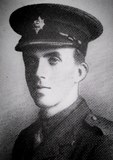
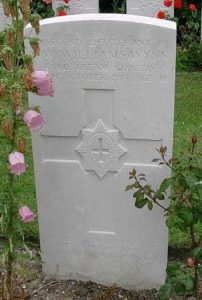
Harry Williams, Private, 11444, Wiltshire Regiment. Harry was born in Llandovery, Carmarthenshire in 1890, the son of Henry and Elizabeth Williams. The family moved to Fronheulog, Llansantffraid-ym-Mechain soon after his birth. Harry had worked as a wheelwright prior to enlisting into the 6th Battalion, Wiltshire Regiment at Lambeth soon after the outbreak of war. The battalion had formed at Devizes in September 1914, joining 58 Brigade, 19th (Western) Division on Salisbury Plain. During July 1915 the Division embarked for France and moved to the Nursery Sector at Calonne for trench initiation alongside the Dehra Dun Brigade. The infantry battalions of the division then began carrying out the usual routines of rotating in the trenches: four days in the front line; four in support; and four in reserve, interspersed with training regimes and carrying out working parties and trench raids. Just south, the British launched a great offensive around the town of Loos on 25 September 1915, and the 19th Division was ordered to attack from its positions at the same time, to attempt to draw enemy attention away from the main battle area. The attacking battalions of the 19th Division were in place by 04.00, and then at 05.50 the men climbed out of their trenches to launch their assault, behind a gas and smoke screen. The assault was a disaster, and heavy casualties were suffered by the 19th Division for no gain. The Division remained in the same sector over the winter and in April 1916 was relieved, moving to the back areas for training before moving to the Somme sector, where it prepared to take part in the forthcoming Somme offensive. The Battle of the Somme opened at 07.20 on 1 July 1916 and the 19th Division remained in reserve for the opening assault, moving forward to the Tara-Usna Trenches during the day. At dawn the following morning, 2 July 1916, the Division moved forward into the front-line trenches before assaulting the village of La Boiselle. Harry was killed in action during the charge that day. The 26-year-old has no known grave and is commemorated on the Thiepval Memorial, France.
John Trevor Williams, Private, 2409, Welsh Guards. John was the son of John and Ellen Williams, of Fownog, Llansantffraid-ym-Mechain. He worked on his parent’s farm prior to the war. John enlisted into the Welsh Guards early in 1915. The Regiment had been raised by Royal Warrant of 26 February 1915, at White City, before landing at Le Havre on 18 August 1915, becoming attached to 3rd Guards Brigade, Guards Division. The Division had seen its first major action during the Battle of Loos, which began on 25 September 1915, and had suffered heavy casualties at Hill 70, before also taking part in the Action of the Hohenzollern Redoubt. The Division had a brief rest in the Calais area, before moving to the Ypres Salient, and held the line at Potijze for several months. At the end of July 1916, the Division withdrew from Ypres and moved to the Somme, before holding the line north of the Ancre for a short period. By 25 August the Guards Division had moved slightly south, and had marched passed Corbie, to Mericourt-L’Abbe. By 9 September the Guards had passed Ginchy, and moved into positions at Guillemont, prior to taking part in the Battle of Flers-Courcelette, the first-time tanks were ever used in action. John was killed in action on the following day, 10 September 1916, during terrible hand to hand fighting for the village of Ginchy. The 19-year-old is buried in Guards’ Cemetery, Lesboeufs, France.
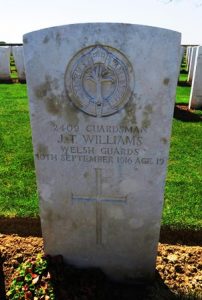
World War Two, 1939-1945
Thomas Tomley Evans, Flight Sergeant, 573381, Royal Air Force. Thomas was the son of Ellis Thomas Evans and Sarah Jane Evans (nee Roberts), of Llansantffraid-ym-Mochnant. He enlisted into the Royal Air Force and after training as an Air Bomber, was posted to 166 Squadron, RAF. The squadron had re-formed at RAF Kirmington on 27 January 1943, equipped with the Vickers Wellington and two days later took part in its first raid, on the German U-Boat base at Lorient. The squadron took part in the night bombing campaign as part of No. 1 Group Bomber Command and converted to the Avro Lancaster in September 1943. On the evening of 22 March 1944 Thomas took off from RAF Kirmington as part of the crew of Lancaster III, Serial JB151, bound for Germany as part of a large bomber force despatched to attack targets in Frankfurt. Soon after crossing into Germany the Lancaster crashed at Welver, near Hamm, with the loss of four of her crew of seven men, three of whom had parachuted out. Thomas was among the dead. The 22-year-old was originally buried beside his three fellow crewmen in Welver Protestant Cemetery, Germany, but their graves were exhumed in August 1947 and the four men were re-interred in Rheinberg War Cemetery, Germany. Thomas is not commemorated on the Llansantffraid-ym-Mochnant war memorial.
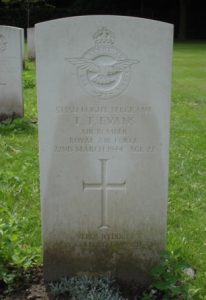
Donald Griffiths, Fusilier, 14759458, Royal Welch Fusiliers. Donald was the son of Thomas Edward Griffiths and Louisa Griffiths (nee Morris), of Waterloo Terrace, Llansantffraid-ym-Mechain. He enlisted into the 4th Battalion, Royal Welch Fusiliers, which was a TA unit, attached to 158 Brigade, 53rd (Welsh) Division. The battalion was mobilised at the outbreak of war, when the Division moved to Northern Ireland to begin garrison duties. The Division then moved to Pembroke Dock, before moving again to the south of England, where it trained in readiness for the D-Day Landings. On 24 June 1944 the 4th RWF left England for Normandy, and landed at La Riviere near Ver Sur Mer. The Division then took part in heavy fighting over the coming weeks, as part of the effort to break-out of the Normandy beachhead, seeing heavy fighting at Évrecy, before starting the epic advance through Northern France into Belgium and Holland. On 15 September the Division forced the crossing of the Junction Canal North of Lommel, and continued to push westwards towards Elst, between Nijmegen and Arnhem, during Operation Market Garden. On 22 October the Division launched its famous assault on ‘s-Hertogenbosch, before continuing its advance to the German frontier. Between December 1944 and January 1945, the Division took part in the Battle of the Bulge, helping in the counterattack which helped save the Americans, who were under heavy pressure, then after the German offensive was broken, took part in heavy fighting to enter the Rhineland, taking part in Operation Plunder, the Rhine Crossings, in March 1945. The Division then advanced through Germany in a series of short attacks, often by single battalions, over the coming weeks. On 23 April 1945, 158 Brigade launched an assault in conjunction with the Guards Armoured Division to cut the autobahn between Hamburg and Bremen at a point about Elsdorf. Donald was killed during the assault. The 23-year-old was originally buried in Abbendorf, but in July 1946 his grave was exhumed, and he was re-interred in Becklingen War Cemetery, Germany.
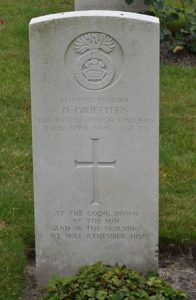
Edward Ivor Griffiths, Flying Officer, 117360, Royal Air Force Volunteer Reserve. Edward was born on 30 June 1917, the son of John Griffiths and Sarah Jane Griffiths (nee Morris), of Llansantffraid-ym-Mechain. He was lodging at Ellesmere prior to the war, where he worked as an insurance collector. He married Jean McCreadie at Liverpool in 1941. Edward enlisted into the Royal Air Force Volunteer Reserve and after training as a Navigator, was posted to 158 Squadron, RAF. The squadron had reformed at RAF Driffield on 14 February 1942, equipped with the Vickers Wellington medium bomber and took part in night bombing operations over Germany and occupied France. In June 1942 the squadron re-equipped with the Halifax II heavy bombers and moved to RAF East Moor, then on 6 November 1942 the squadron moved to RAF Rufforth. On 18 February 1943 Edward took off from Rufforth as part of the crew of Halifax II, Serial DT644, which had been despatched to carry out gardening operations, mine-laying, in the North Sea. The aircraft was lost in the sea off the Friesian Islands that day, with the loss of all seven of her crew. Edward was 25 years old when he lost his life that day and is commemorated on the Runnymede Memorial, Surrey.
Reginald Hillman, Guardsman, 2615895, Grenadier Guards. Reginald was born in Shropshire in 1921 and lived at Llanfechain prior to the war. He enlisted into the army and was posted to the 4th Battalion, Grenadier Guards. The battalion was among several new battalions raised for war between October 1940 and October 1941, and converted to an armoured unit, as part of the 6th Guards Tank Brigade Group. The battalion landed on the Normandy beaches in June 1944, and saw heavy fighting during Operation Bluecoat, then during the Battle for Caen, particularly in Operation Goodwood. Reginald was killed in Normandy on 14 August 1944. The 23 -year-old was originally buried on the battlefield, but after the war his grave was exhumed, and Reginald was buried in Bayeux War Cemetery, France.
Bertie Jones, Private, 5570249, Wiltshire Regiment. Bertie was the son of Benjamin Jones and Charlotte Jane Jones (nee Evans), of Llanrhaiadr-ym-Mochnant. His father was killed in France in 1917 and in 1923 his mother married George Stanley Bolter. The family then resided in Llansantffraid-ym-Mochnant. Bertie was a regular soldier, who had enlisted into the 2nd Battalion, Wiltshire Regiment prior to the war. The battalion was attached to the 13th Infantry Brigade, 5th Infantry Division and embarked for France with the British Expeditionary Force in December 1939. When the German Army launched its attack in the West on 10 May 1940, the 5th Division took part in the initial engagements in Belgium. Bertie was posted as missing, believed killed in action, at some time between 23 May and 4 June 1940 during heavy fighting along the Ypres-Comines Canal. The 23-year-old is buried in Oostaverne Wood Cemetery, Belgium. Bertie is not commemorated on the Llansantffraid-ym-Mochnant war memorial.
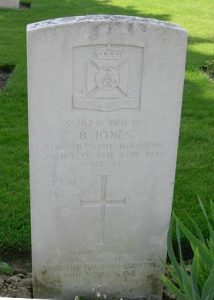
Ernest Richard Morralley, Private, 4029693, Royal Army Ordnance Corps. Ernest was born in Bristol on 17 July 1907, the son of John Morris Morralley and Ellen Louisa Morralley (nee Jay). His father was from Llansantffraid, and Ernest resided with family at Church View, Llansantffraid-ym-Mechain prior to the war. He enlisted into the Royal Army Ordnance Corps and was stationed in Cardiff, probably at the Royal Ordnance Factory there. Ernest died at the Royal Infirmary, Cardiff on 7 September 1940. The remains of the 32-year-old were brought home for burial in St. Ffraid’s Churchyard, Llansantffraid-ym-Mechain.